Metadata and Citation
Last updated on 2024-09-27 | Edit this page
Overview
Questions
- What is metadata and why is it important, and what is best practice around metadata?
- What does good metadata look like?
- I can cite/people can cite my code?
- What do you want people to access if it’s cited?
- How do I cite code?
Objectives
- Understand the role and need for metadata for your outputs
- Know what best practice is and be able to apply it
- Learn from examples of good metadata
- Understand the importance of citing all work
- Be able to think about what should be cited
- Know how to cite code, and how others can cite you
Metadata
Introduction
Simply put, metadata is data about data (hence meta). This might not be that helpful a description however, but is necessary as it holds true across all types of metadata. If we continue with the idea of depositing your code in a repository as we saw in the previous episode, however, it becomes much clearer. The metadata is the data that’s on the deposit ‘front’ page, so to speak. It is there to inform anyone who comes across the deposit what they have found without them having to dive too far into the actual data or code.
Can you show me some good metadata?
Of course, however, it might be more interesting to look at some bad metadata, as it’s probably more effective in showing how important metadata can be.
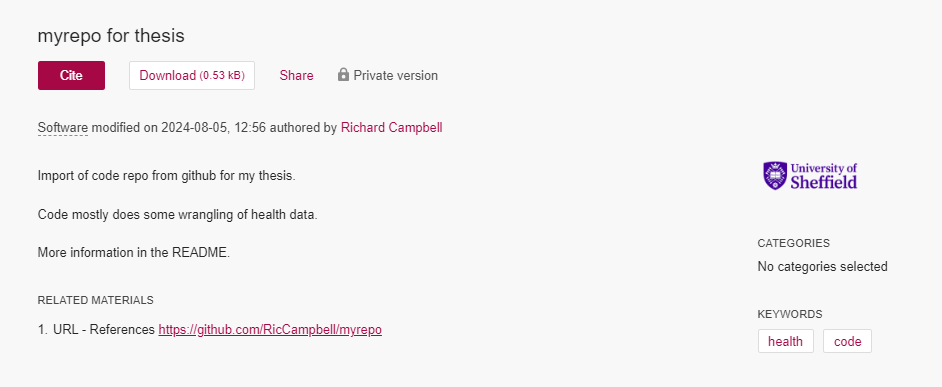
As you can see there, there’s some information about the deposit, but it’s probably not nearly enough for anyone to know what it really is, or if it’s useful to them. This code could be perfect for someone to use, or adapt, but they wouldn’t know without having to do a lot of work to figure this out. There is a link to the GitHub repository, but that’s probably not got any more information in it, and still, as we’ve seen, that wouldn’t enable someone to reference your work. (N.B. There’s no DOI on this deposit, as it’s just a draft - we wouldn’t really accept a deposit into ORDA that had so little information - another good reason to think about metadata, as ORDA isn’t an outlier in this regard).
But there is a README there, which asks the question:
Is a README metadata?
It’s a good question, and one I’m sure people would argue over as they have different views on it. Technically, metadata is for finding software, while documentation, including READMEs, are for understanding it. However, the thing that actually matters is that you should probably have a README, and metadata, and other documentation as well. READMEs and other documentation (comments etc.) should be created early and updated as you go along, with potentially metadata being created later in the lifecycle. However, a good README may directly feed into your metadata. There’s no problem with copying and pasting elements; in fact it can be beneficial: it saves you time, and makes sure everything is consistent.
It might be worth thinking of metadata as the overarching information about your code. A README goes into more detail but covers the whole software/project, and comments etc are much more fine-grained documentation relating to the places in the code where they reside.
There is a Documentation module on this FAIR24RS course, which goes over all things documentation in more detail.
Challenge
What metadata do you think should be included in a deposit?
Think about what you might want to see if you were reusing code (i.e. a package), or what you probably take for granted that you know about your code
- Name (a good one)
- (Lay) summary
- A description of what it is
- What language is it in, and versions
- Provenance
- It’s licence (see licence section)
- Any related material
- Dependencies
- File structure
These might not even be everything depending on what you have created. You might want to have use cases, the target audience, key features, compatibility etc. The point is to have information that reduces the workload or thought that someone has to take on in order to know what it is they’re looking at, and if it’s useful to them.
None of these are world-changing ideas, but they do require some thought:
Callout
“There are only two hard things in Computer Science: cache invalidation and naming things.”
– Phil Karlton
You may have heard or seen this quote before, but it does stand true: naming things is hard. This principle is normally applied to variables, but it does carry over to other elements too. Creating a short, informative summary or description can be tricky, but doing that using no specialised vocabulary makes it harder, as does trying to include all the less tangible, or overarching, elements that you know about your work but others do not.
If we go back to the example of bad metadata that we saw earlier, there are actually two bits of information there that are helpful.
- It’s got the right type of item type selected, as it’s down as ‘software’, which makes it easier for people to find and know immediately what it is.
- It also mentions that it’s mostly to do with ‘wrangling of health data’. This is not much information, but it can be very easy to forget the most simple elements. If you’ve only ever worked with health data and written plenty of bits of code to help, you might not think to mention this very high-level piece of information.
Machine-findable
It’s best when thinking about creating metadata that you think of human users. It’s also really good to think of yourself as one of these users, either yourself a few years ago, when you might have known less of the area and might not have known exactly what you were looking for, or yourself in a few years, when you’ve most likely forgotten everything about this code, why you made it, and what exactly it does.
However, you also get a bit more findability for free by creating metadata, as these fields are often used and standardised for machine readability as well.
A good example
We’ve seen a bad example, but what would a good example look like?
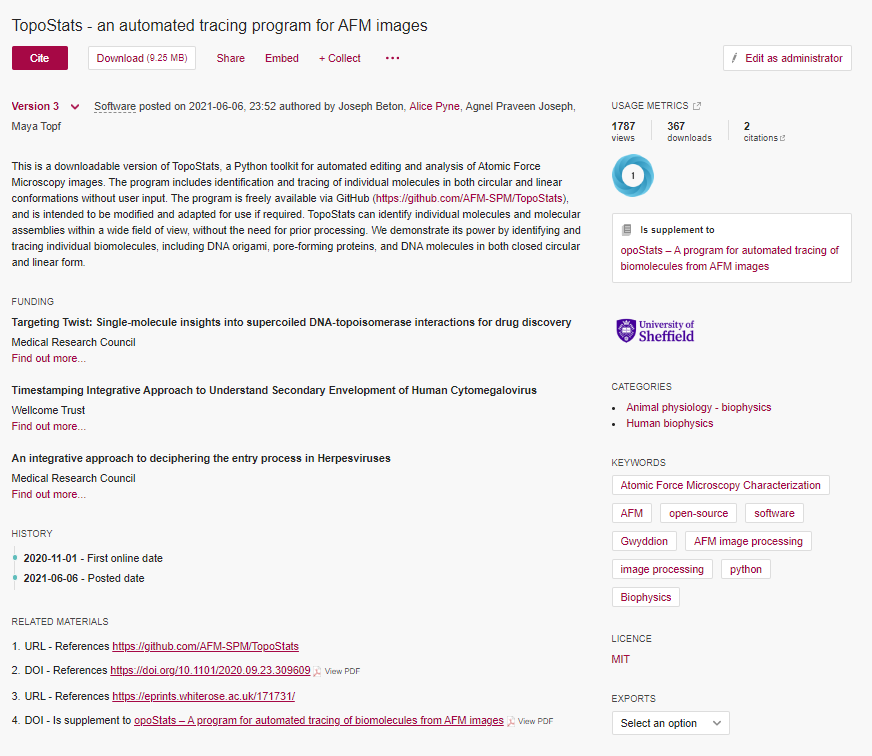
Can you pick out the good (and bad) elements of metadata in the above deposit?
- Author names
- Version number
- Date created
- Item type
- A clear name
- A clear description
- Licence
- Categories and keywords
- Related materials including a link to the relevant paper
- Initialism in title (bad)
There’s also the language that it is written in, both in the description and the keywords. The first three listed, names, version, and date, would all fall under what was previously referred to as provenance. As you can see, a lot of these are fields you probably have to complete when making a deposit to a repository, which makes it easier, but if you are taking a different route, these could be easy to miss out. It’s also important that you keep these items up to date if they change. Do also take a bit of time to consider them - for example, it’s not good form to miss someone off an author list, and this applies to software author lists as well.
Standards
As we’ve just seen, a repository, even a GitHub repository, has fields for some of this information and these will be implementing a standard, but if you are adding metadata that isn’t a standard GitHub/repository field, or creating your own metadata document, you might need to consider using a standard for your metadata. Some examples are schema.org’s SoftwareApplication type, and CodeMeta. These help tools to work with your metadata by having a set standard. For example if you created it now, what would you call your author list field? Possibilities might be author_list, authorList, developer, developers, writer, creator, coders etc., are all these synonymous with each other for everyone? Would you complete those fields the same for your project? Implementing a standard stops this from happening, each field has a precise meaning and information on how to complete/read.
You’ll have come across standards before, of course, when you download citations of papers for your reference manager software:
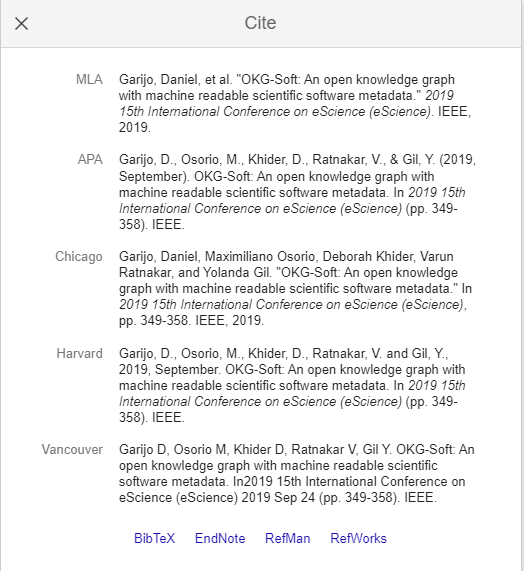
Key Points
- Metadata helps drive discovery of your software
- It’s easy to not include key elements as these are ‘obvious’
- Standardisation of metadata is useful to help tools use the metadata
Citation
Introduction
If we go back to the first thing that was stated in this module,
The code that you write is important. No matter the size, style, or language, it is an integral aspect of the research that it is part of, or indeed, sometimes it is the main output of the research project.,
This also applies to code that other people write. That’s why it’s important to know that you can (and should) cite other people’s code when you use it, and also how to enable other people to cite yours.
DORA, funders, and the (hidden) REF
DORA, The Declaration on Research Assessment, sets out to improve the ways in which the outputs of scholarly research are evaluated, essentially moving away from a focus on the impact factor of journals that you publish in. The University of Sheffield is a signatory of this declaration. DORA prompts institutions and the sector as a whole to consider different ways of evaluating research quality, including assessing the quality of all research outputs (e.g. datasets, code) as well as published journal articles, and encouraging recognition of all authors’ contributions.
We’re also seeing a continued movement from funders to make open and available all aspects of research projects as the importance and cost of all elements are more fully recognised. For instance, we’ve seen this with data, with a lot of funders requiring (where suitable) this to be made openly accessible, and we’re also increasingly seeing it with code. Making things open and reusing existing work are both important goals, and ensuring people get the recognition they deserve from their work is essential (and also in most cases a legal necessity - see licence section of this module, or software Terms and Conditions e.g. SAS).
There’s also been some movement with the REF as well, with more types of outputs being considered eligible to be returned, and if we think about impact case studies, a useful piece of software could easily have a substantial impact. There are also movements like the Hidden REF, whose objective is to gain recognition for all people who contribute to research, and are also wanting institutions to pledge to making 5% of their REF returns non-traditional research outputs (i.e. anything that’s not a journal paper or book).
These are also all good reasons not to simply cite the associated paper for a piece of software (if there even is one), but to cite the software itself - and to make it easy for others to cite your own code.
Citation and CITATION.cff files
Citation of software is of course different to that of a standard journal article. Normally there is one version of an article and nothing that can really ‘break’ with them; this is not true of software. Also, a paper tends to have all the information you need to cite it correctly quite clearly there for you - again, this often isn’t the case for software.
Challenge
Think what people might need to know from a citation to be able to reproduce a piece of research. (I.e., to make sure they’re using the same piece of software used in the original study?)
Some of the main things to know about the software used that would be integral to being able to reproduce the outputs would be:
- Title
- Authors
- Version used
- Where to find the software
- How to access the code (if different to the above, and available)
The first two, while it’s clear that they should be part of a citation, might not immediately seem relevant when thinking about reproducibility, but if you think that they can sometimes act as a kind of ‘primary key’ to help people know they’re working with the right software (see the last episode and its discussion of naming things).
The bottom three you can see would be needed in order to be certain you can reproduce the work as best as possible. We know that many changes can happen between versions, some big changes, some small changes that could have knock-on effects to how everything works. Of course, where to find the software goes back to our first episode, and having a solid pointer to the code can be solved by getting a DOI for your work (you should of course not mint a DOI for other people’s work, and you might just have to cite the best link available).
CITATION.cff files are designed to pull together
everything you or others need in one place. Similar to README, or
LICENCE files, they are top level files that contain in a standardised
fashion all the information required.
This is an example of a CITATION.cff file (the one for
this module):
This CITATION.cff file was generated with cffinit.
Visit https://bit.ly/cffinit to generate yours today!
cff-version: 1.2.0
title: 'Software dissemination and impact'
message: >-
If you use this software, please cite it using the
metadata from this file.
type: software
authors:
- given-names: 'Jenni'
family-names: 'Adams'
email: 'j.adams@sheffield.ac.uk'
affiliation: 'University of Sheffield'
orcid: 'https://orcid.org/0000-0003-2420-0763'
- given-names: 'Ric'
family-names: 'Campbell'
email: 'r.j.campbell@sheffield.ac.uk'
affiliation: 'University of Sheffield'
orcid: 'https://orcid.org/0000-0002-0975-9270'
repository-code: 'https://github.com/RicCampbell/FAIR4RS_repos_dois'
url: 'https://github.com/RicCampbell/FAIR4RS_repos_dois'
abstract: >-
While putting your software online certainly helps it satisfy the FAIR principles, simply doing so might not be enough for other researchers to actually find and utilise what you’ve put out there.
It’s important to know the benefits and issues with where you store and publish your data, and to make the most of the tools these platforms provide, such as Digital Object Identifiers (DOIs). It’s also important to know best practice for how to increase the visibility and citability of your work in cases where your chosen platform lacks these features.
This course will introduce and explore worked examples of elements that you should consider when publishing your software, which will help you easily reference your work, and also help make it more findable and reusable by others.
keywords:
- carpentries
- fair4rs
- university of sheffield
- repositories
- dois
- metadata
- citation
license: CC-BY-4.0As you can see, this has all the relevant metadata needed for full citation, and you can see where it was created. This has also been updated manually as well when things have changed, but there are lots of places online where you can see the fields needed and the style they should be in if you have a quick search.
If this is inside a GitHub repo, then on the right hand side, you will be able to get the citation text, or download one to be imported into a reference manager, via a BibTeX file.
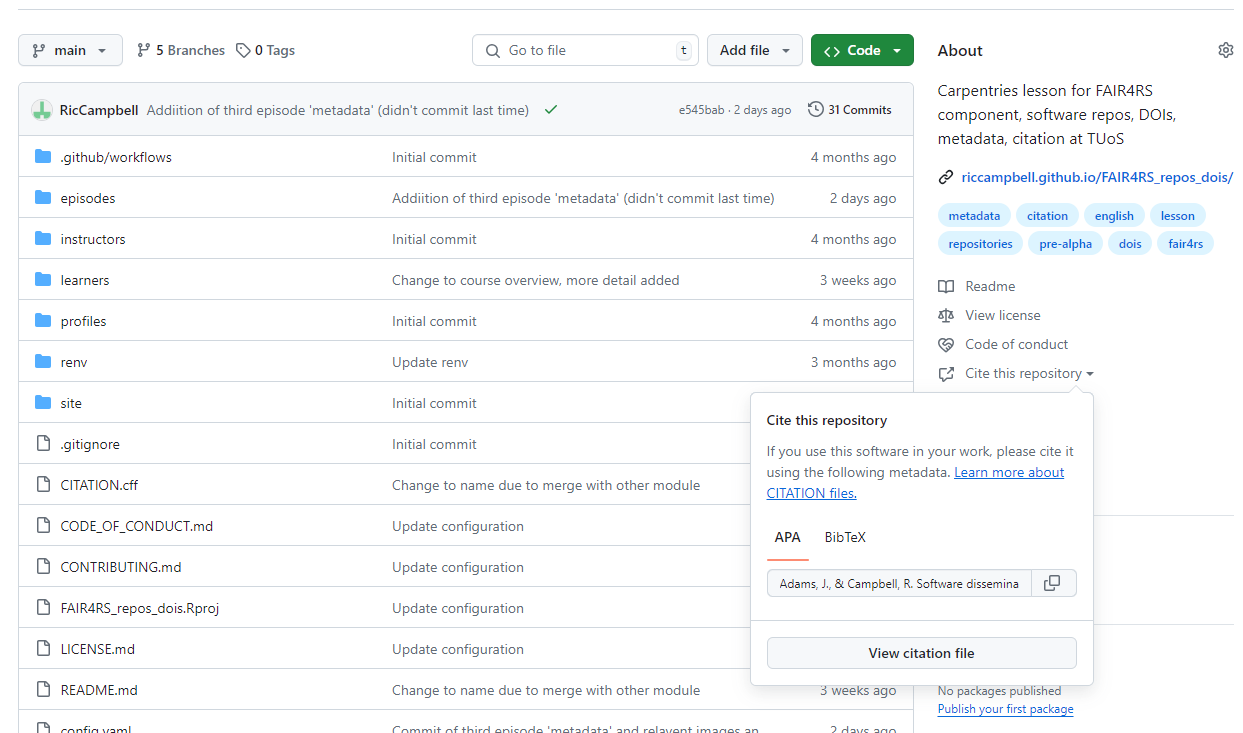
So this is great for people citing your work and for getting the correct information to cite other people’s work.
Not all citations are created equal
GitHub is not the only platform to make use of
CITATION.cff files; however, not every platform or
repository uses them either. As previously mentioned, you can link your
GitHub repos to ORDA, the University of Sheffield repository, and ORDA
has an easy way of creating citations as well:
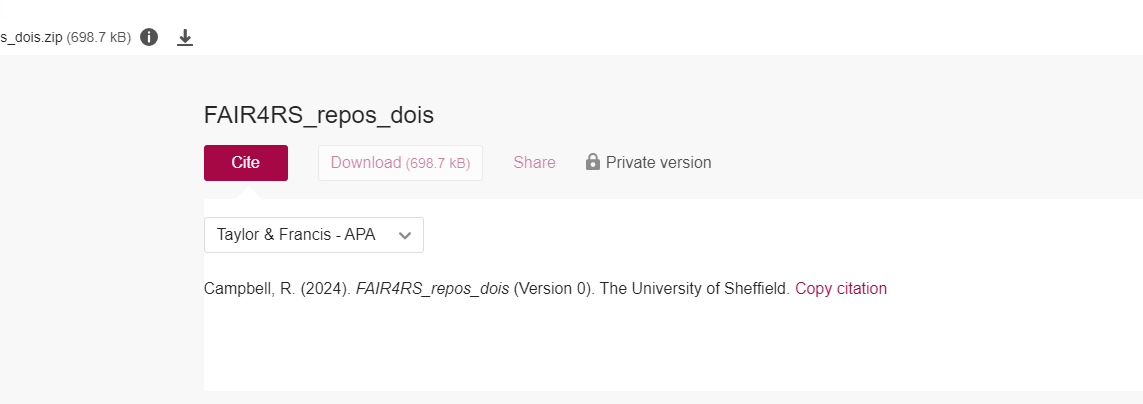
However, the two citations that we’ve just seen for the same output
are not the same. The issue comes with the fact that Figshare (which the
University of Sheffield repository, ORDA, is an instance of), does not
look in the CITATION.cff file, but instead creates one from
the metadata that is entered for the deposit. In this example, the
author list is different as I’ve entered all authors into the
CITATION.cff file, but have not edited this in ORDA. It’s
easy to add these, but it means repetition of work. While this isn’t
ideal, it’s important to try to get everything the same where possible.
You don’t know where your work may end up once it’s been made open, so
controlling what you can to start with really improves chances of the
provenance being kept with it, and the ability of people to find the
original repository. The CITATION.cff file should also
always be kept with your work if it does get shared onwards, and helps
to this end as well.
GitHub citation:
Adams, J., & Campbell, R. Software dissemination and
impact [Computer software]. https://github.com/RicCampbell/FAIR4RS_repos_dois
ORDA citation;
Campbell, R. (2024). FAIR4RS_repos_dois (Version 0).
The University of Sheffield.
Extending your CITATION.cff file
There are also a lot of standardised fields that you can add to your
CITATION.cff file, other than the ones we have already
seen. You can link to a related journal article if there is one, or you
could cite a dataset that is contained in your GitHub repo. For more
information about these extensions, GitHub provides an easy-to-follow help
page on the subject.
Key Points
- Citation is important to ensure that the correct recognition and credit is assigned to all work
- Citation of software differs from that of articles, but is needed to aid the reproducibility of work
-
CITATION.cfffiles should contain all the necessary metadata and help create citations for use. - You may need to complete the relevant fields in multiple places to ensure correct citation in all cases.

